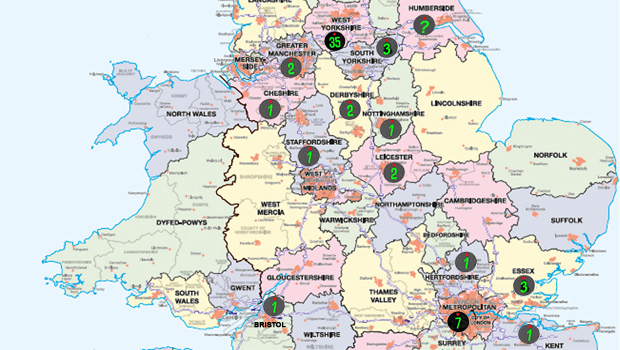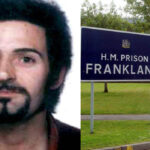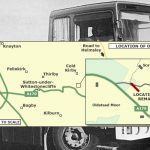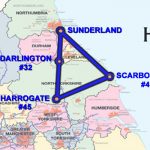The Ripper Strikes South
by TIM HICKS & CHRIS CLARK
~~~~~
Introduction
Following on from the new evidence gathered by the authors and NYE citizen journalist Nigel Ward, and revealed in the article “Hope”: New Evidence.
The authors have had time to consider the impact that this new evidence has had on their knowledge of the full range of Yorkshire Ripper Peter Sutcliffe’s pattern of offending. It is quite startling.
Background: Numbers of victims
Peter Sutcliffe’s reign of terror finished on the 2nd of January 1981 when he was arrested in Sheffield by South Yorkshire Police, armed and with a prostitute. This woman was no doubt intended to be another of his victims and his arrest (and hers) certainly saved her life.
He was convicted of having committed thirteen murders and seven attempted murders.
These are shown in Table 1. In addition to the offences he was convicted of, he admitted two offences and was not charged in another four, which are also shown in Table 1 below.
An antecedent investigation conducted by Chief Constable Sir Lawrence Byford – which has never been released to the public in full, only a redacted copy – is believed to have identified another murder and eight attempted murders that Sir Lawrence was satisfied that Sutcliffe had committed.
These are shown in Table 2 below.
A grand total of thirty-five murders and attempted murders, tightly and conveniently concentrated in the West Yorkshire, South Yorkshire and Greater Manchester force areas.
A similar investigation to Sir Lawrence Byford’s conducted by Assistant Chief Constable Keith Hellawell for West Yorkshire Police originally looked at 78 additional cases which he firstly reduced down to 60 then down to 45 and eventually, because of weight of numbers, down to a final 22. Twelve in West Yorkshire and ten elsewhere. The victim names have never been released.
Ripper Spreadsheet 1
Table 1, Table 2 and Table 3
Sutcliffe’s offending was perceived to be limited to offences localised to the GMP, WYP and SYP force areas. In all of these offences, he was believed to have used his own vehicle.
Other than the attempted murders of Ann Rooney and Tracey Brown – which he admitted – Sutcliffe has denied committing all of the many offences that were put to him after his conviction.
Neither of the authors were convinced by the accepted police assessment of thirty-five attacks, or by Sutcliffe’s denials.
Chris, however, took it a stage further and using his experience as a police intelligence officer, conducted his own antecedent investigation into the full extent of Sutcliffe’s offending. This was published in his book “Yorkshire Ripper The Secret Murders”, NYE review here.
Chris’s investigation revealed a far wider pattern of offending. The author’s assessment is that Peter Sutcliffe should be considered as a suspect in at least sixty-five murders and attempted murders over multiple force areas, not the thirty-five in West Yorkshire, South Yorkshire and Greater Manchester recognised by the police. These are shown in Table 13 below, which has been continually updated by the authors as more information has emerged.
Ripper Spreadsheet 6
Table 13 Victim list and vehicle access
The authors assert that this is the most comprehensive assessment of the potential number of Sutcliffe’s crimes available anywhere.
The most concerning of these four tables is Table 3. Please note the difference in the numbers of attacks compared to 1977. Serial killers generally become more prolific as time progresses because they acquire a taste for killing, enjoy it more, become more confident and also more skilled at what they do. However, the frequency of Sutcliffe’s known murders is not consistent with this pattern. It shows a peak in 1977, when one would expect it to show a steady rise in the number of attacks over the period of his offending, with the peak in 1980.
This leads the authors to conclude that it is still incomplete. They fear the true number of Sutcliffe’s victims is probably very much higher than the sixty-five the authors have identified above. Far-fetched? Chief Constable Hellawell’s initial assessment, remember, was seventy-eight.
Sutcliffe’s access to vehicles
Sutcliffe was a car and motorbike enthusiast and enjoyed driving. During 1963, at age seventeen, he obtained a provisional driving licence and was stopped and reported by Keighley Police for driving a motor car whilst unaccompanied and failing to display L-plates.
There was a similar case against him during May 1964. During this time, Sutcliffe was heavily into motorcycles, which interest would continue until the late 1960s. During a Sunday night in March 1965, when he was age 19, he was seen with another man trying door handles of several unattended motor vehicles in Old Main Street, Bingley, beside the River Aire. Both were arrested for attempting to steal from an unattended motor vehicle and appeared at the Bingley West Riding Magistrates Court on 17 May 1965.
His address was given as 57 Cornwall Road, Bingley, which was his parents’ address. He was fined £5 and his fingerprints would have been taken then. His descriptive form included that he had black curly hair, brown eyes and (at that time) a fresh, clean-shaven complexion. Sutcliffe gained more motoring convictions during 1965 and 1966.
Sometime during 1965 or 1966, Sutcliffe had an accident on a motorcycle whereby he received a head injury, which he claimed at his trial in 1981 had given him depression.
Sutcliffe had been able to drive since he was age 17 but didn’t hold a full licence until he was 22, during 1968. This restricted his driving ability to go further than his local district until then.
Other than one attack in 1969 (4), where he used a friend’s car, in all the offences accepted as having been committed by Sutcliffe in Tables 1 and 2, he used his own car.
During February 1975, Sutcliffe took redundancy from Anderton International and used part of the £400 payoff to train for an HGV licence. He trained as an HGV driver in the Harrogate area in February 1975. Two days after his 29th birthday, on the 4th of June, 1975 Sutcliffe gained a Heavy Goods Vehicle driving licence.
Sutcliffe then started employment as a lorry driver on the 29th of September 1975 working for a Common Road Tyre Company, Okenshaw, situated at the junction of the M62 motorway and a spur off the M606 into Bradford; the work involved short and medium distance hauls all over the North and the Midlands. He used the experience to familiarise himself with the network of motorways and trunk roads linking its destinations to each other including the best access routes to many towns and city centres. Capitalising on his already extensive knowledge gained from socially driving around the North of England, the Midlands, London and Home Counties. He collected a small library of A-Z indexes of British cities so he could operate in them. He travelled widely.
However, after just over a fortnight’s employment, on 15 October 1975, Sutcliffe was caught stealing second-hand tyres and the police were informed. He was arrested and during the following year, after entering a guilty plea at a later court hearing on 5 March 1976, and was fined. He was sacked that April for bad time-keeping and was then unemployed until he started working as an HGV driver in October 1976.
In summary, Sutcliffe worked as an HGV driver in Bradford from October 1975 to March 1976 then from September 1976 until his arrest in January 1981. Giving him access to a lorry, during these two periods when he was driving all over the UK unsupervised.
His use of vehicles is shown in Table 13 above. Please note the key to his vehicle use:
V1: No car
V2: Victim’s car
V3: Own car
V3a: Own car, accompanied by a friend
V4: Friend’s car
V5: Employer’s lorry
V6: Own car, false plates
False number plates
Sutcliffe was arrested on the 2nd of January 1981 in Sheffield with a prostitute, in his car with false plates, armed with a hammer, two knives and a ligature. This was the only time his use of false number plates was connected to a Ripper attack. He had taken the false plates earlier that day from a scrap yard in Cooper Bridge, near Mirfield. They were from a Skoda saloon that had been written off in an accident. Obviously they were obtained specifically for this attack which was out of his usual area of operations in West Yorkshire and Greater Manchester.
According to employees at T&WH Clark (Holdings Ltd), Sutcliffe occasionally turned up at work with false number plates on his car. Yet the police did not find any false plates when they searched Sutcliffe’s home. The conclusion is inescapable that when he operated out of his local area, he sometimes bought false plates on the day of the attack, so he could not be traced by the police surveillance. He ditched the plates shortly afterwards, so they could not incriminate him.
It must therefore be a concern that there were other occasions when he used false plates in attacks outside West Yorkshire, which were never attributed to him.
Sutcliffe’s offending, by police force areas
Sutcliffe did not recognise the concept of “no go areas” that were immune to his offending. He was forensically aware and capable of planning. The police suspected from geographic profiling that he was based in West Yorkshire. His arrest in Sheffield in 1981 demonstrated that he varied his areas of operation (until that point he was thought to operate only in West Yorkshire and Greater Manchester) to ensure his offending was not attributed to him.
There is no doubt that Sutcliffe struck South, West and North.
Northern Police Forces
The authors believe Sutcliffe committed at least three attacks North of the West Yorkshire Police force area in the Harrogate, Sunderland, Scarborough triangle. These are covered in our article The Ripper Strikes North.

The Scottish Attack(s): Police Scotland
Sutcliffe is known to have operated in Scotland. The authors believe he should be considered as a suspect in the murder of 18-year-old Diane Webster from Stenhousemuir (55).
The Western Attacks: Greater Manchester Police
For some of Sutcliffe’s attacks, he left his primary hunting grounds in West Yorkshire and struck west along the M62 into Manchester. Because of Manchester’s proximity to West Yorkshire this was recognised at the time and, so far as the authors can tell, his offending in Manchester was fully identified in the Ripper Enquiry (See Table 1 and Table 2) and attributed to him.
The Southern Attacks.
Sutcliffe was arrested in South Yorkshire, in a car bearing false plates, armed and in the company of a prostitute. He undoubtedly intended to kill her, but was never charged with any offence in connection with this planned attack.
The authors believe that this was not the first time he had operated in South Yorkshire. In particular, the attacks on Barbara Young (29) and an unknown Doncaster prostitute (38) were not attributed to him, although the authors believe he should have been considered as a suspect. Nor was he charged with the attempted attack on Olivier Reivers (65) which led to his arrest.
As shown in Table 13, there are a long list of attacks in other force areas the authors believe Sutcliffe should be considered a suspect for.
Did the Ripper Strike East?
Given that Sutcliffe used the M62 to travel into the GMP area, it is equally possible that he may have used it to strike into Humberside. Certainly this was considered a possibility at the time and Humberside Police put the red light district in Hull under surveillance in anticipation of a Ripper attack.
The authors have considered this possibility but are not aware of any Humberside connection, even though it would be a clear drive from Bradford for deliveries to the Continent. They are unable to identify any case in the Humberside Police area of a murder or attempted murder that Sutcliffe should be considered as a suspect for. With missing person’s it is a different situation, because the information on missing persons available from open sources is very limited. We know from the “Nude in the Nettles” and Yvonne Pearson cases that Sutcliffe concealed bodies. It is therefore possible that some cases of missing persons in the period from October 1975 to March 1976 then from September 1976 until his arrest in January 1981 are in fact victims of Sutcliffe that were not identified as such at the time, or in the subsequent 1981 investigation.
The Missing Ones: The implications of the Yvonne Pearson (40) and “Hope”/”Nude in the Nettles” (51) cases.
One of the major revelations to emerge from Chris’s work is that it became clear that Sutcliffe was forensically aware and routinely changed his modus operandi, to confuse the police investigation. He used different weapons (ball pein hammer, claw hammer, masonry/lump/walling hammer, knife, ligature, cross head screwdriver, bradawl made from a sharpened cross head screwdriver) to kill and mutilate his victims. He changed his car regularly and varied his geographical area of operation. As an example, the foray into South Yorkshire in 1981 was undoubtedly due to his caution in avoiding the red light districts in West Yorkshire, because he knew they were under close police surveillance.
Arguably the most puzzling of Sutcliffe’s attacks was his murder of Yvonne Pearson (Case 40 A15). This appeared to be unique because Sutcliffe deliberately concealed the body beneath a sofa and it remained undiscovered for two months. NYE article with more information here.
The body was only discovered because a passer-by noticed an arm poking out from the sofa. When the body was removed, the police found a newspaper underneath the body dated the 21st of February 1978. The police investigation identified that other witnesses who had passed the sofa confirmed that there had been no arm showing in the period between the murder on the 22nd of January 1978 and the discovery of the body.
They concluded – correctly, in both authors’ opinions – that Sutcliffe had returned to the body, placed the newspaper underneath the body, hoping the police would use the date on the newspaper to establish the wrong date for the murder. Thereby establishing a false alibi for himself. He then moved the arm so it was exposed, to ensure discovery of the body with the newspaper underneath it shortly afterwards.
In their article The Ripper Strikes North, the authors covered two murders and an attempted murder they believe were committed by Sutcliffe, but never attributed to him by the police. One of these is the famous “Nude in the Nettles” murder of a woman who remains unidentified and whom the authors have called “Hope”. The authors have recently made a major breakthrough in this case. Article here, which North Yorkshire Police are ignoring.
“Hope’s” body was also concealed (two years, not two months) and a dated item (a yoghurt top) put underneath it. The authors believe this was to establish a false alibi. Exactly the same method used in the Yvonne Pearson attack. This deduction has profound implications. It has enabled the authors to expand their analysis of Sutcliffe’s offending, both in terms of his modus operandi and the geographical extent of it.
The implication of the new evidence developed by the NYE is that:
- Sutcliffe picked up his victim “Hope” from Scarborough in his lorry.
- Sutcliffe’s lorry had a large cab and could be used to sleep in. Here opinion is divided between the authors. Sutcliffe never contaminated his vehicle by killing in it and therefore Chris is convinced that Sutcliffe would not have murdered anyone in the cab of the lorry. Tim is not so convinced. Ligature strangulation leaves no blood and is quiet. Tim believes it is just possible that Sutcliffe may have murdered in the cab using ligature strangulation. This would certainly be a departure from Sutcliffe’s known modus operandi, but Sutcliffe often varied his modus operandi. He is also known to have fanatically cleaned his cab, which would destroy any forensic evidence. So Tim believes this cannot be ruled out.
- Sutcliffe concealed the body.
- Sutcliffe checked the newspapers to identify if the body had been found, then having ascertained it was undiscovered, returned later to place the dated yoghurt top underneath it. Thereby establishing a false date of death and an alibi. Had he not done this the records of his employer would show the exact dates that he had been in Scarborough. If the body was discovered the day after the murder, this would tie him to it.
The authors therefore assert that Sutcliffe practised another previously unrecognised and distinct modus operandi of using his employer’s lorry to commit murders and then concealing the body to evade detection.
This is a major development. When Sutcliffe was arrested in 1981, all forces conducted a review of their unsolved murders to ascertain if they had been committed by Sutcliffe. However, the Yvonne Pearson murder being seen as an isolated one-off from his normal modus operandi. At the time it was not realised that Sutcliffe also concealed bodies.
Consequently Sutcliffe was not believed to be responsible for murders of women that had disappeared and were classified as missing persons. This has only been revealed as a result of Chris linking Sutcliffe to the “Nude in the Nettles” murder and the fresh evidence this has generated. So missing persons were not included in the Yorkshire Ripper antecedent investigation.
It means that Sutcliffe could have been committing murders while travelling in his lorry, or staying in lorry parks all over England and concealing the bodies. If so, there could be missing persons cases in these force areas that Sutcliffe was responsible for, which are classified as missing persons, but are in fact murders.
This could be because:
- The criteria for identifying a Ripper attack issued by West Yorkshire Police to all forces (the Charlesworth criteria) were misleading. So some Ripper attacks may have been eliminated in error.
- The official line was that Sutcliffe only operated in Greater Manchester and West Yorkshire. Therefore women that were attacked outside those areas will certainly not have realised that they had been attacked by the Ripper.
- Prostitutes have an adversarial relationship with the police. It is therefore possible that some of Sutcliffe’s victims who survived his attacks will not have reported the attack to the police for fear of being arrested for soliciting.
- Some of the victim’s bodies were concealed.
- Sutcliffe was not linked to some crimes because his car had false plates.
This would account for the fluctuations in the numbers of attacks in the later years of his offending revealed by Table 3.
Summary
The authors assessment of the crimes for which Sutcliffe should be considered a suspect by force area is as follows:
Core central area of offending in West Yorkshire
West Yorkshire: 35
North
North Yorkshire: 2
Durham: 1
[These were covered in the article The Ripper Strikes North and are shown in the lead illustration at the top of this page]
Police Scotland: 1
West
Greater Manchester: 2
South
South Yorkshire: 3
Staffs: 1
Derbyshire: 2
Leicestershire: 2
Metropolitan: 7
Essex: 3
Notts: 1
Cheshire: 1
Hertfordshire: 1
Avon & Somerset: 1
Kent: 1
Sussex: 1
It now appears that eleven of these murders were committed from Sutcliffe’s lorry. The authors will be covering this in greater detail in their next article “The Ripper’s Lorry Murders”.
As usual, we conclude the article with an appeal for information on the murder of “Hope”.
NYE Appeal for information
“Hope”

Three-dimensional wax reconstruction of the victims head and face
- She was 5’ 2” in height, aged between thirty five and forty.
- She had a slender build and wore her natural dark brown hair in a page-boy style.
- She had given birth to two or three children and had a displaced septum between her nostrils.
- Her toenails were painted pink – the varnish coming from the Max Factor Maxi range.
- She would have worn a size four shoe.
- Staining on her teeth revealed that she was a heavy smoker that did not look after herself.
- She had a Yorkshire or Lancashire accent, but may not be originally from Scarborough.
- All her upper teeth were missing, she had an upper dental plate fitted, and she had only six lower teeth.
- She had an old fracture to her right ankle and an abnormality to her neck vertebrae which would have caused backache.
- Do you remember someone like this from the shelter in Victoria Road?
- Were you one of “Hope’s” clients?
- Were you a police officer in Scarborough in the period 1977 – 1979? Did “Hope” come into custody for being drunk and disorderly, soliciting or vagrancy, or did you see her at the shelter?
- Were you a social worker, health care professional, or member of the Salvation Army that came into contact with “Hope” and other down and outs from Victoria Road Scarborough?
- Did you find a dark blue quilted body warmer, blouse, jumper, dark mini skirt discarded along on the A170?
Peter Sutcliffe

Peter Sutcliffe pictured in his TW Clark lorry circa 1976
- Did you see Peter Sutcliffe (Image at beginning of the article) or a lorry from TW Clarke (image above) in Scarborough or any of the locations mentioned in the article?
- Did you work at Victoria Road, Roscoe Street, Andrews of Scarborough (motorcycle dealers), Deardens builders merchants, North Sea Winches, D Wray and Sons, Scarborough Ignition Co Ltd or Pickups or the old goods yard which is now Sainsburys?
- Were you a taxi driver for Boro Taxis next to the café, or did you use taxi’s from there?
- Did you frequent the café in Victoria Road and see Peter Sutcliffe there?
- Did you know the café owner Iris Scott?
If you have any information on the “Nude in the Nettles” mystery that you want to pass on confidentially, you can talk to a journalist by contacting the North Yorks Enquirer using our letters@nyenquirer.uk address. All responses will be treated in the strictest confidence.



























Comments are closed.